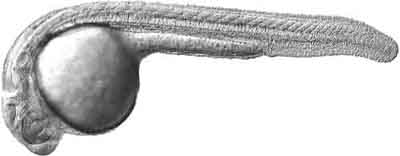The zebrafish (Danio rerio) is a small tropical fresh-water fish which lives in rivers of northern India, northern Pakistan, Nepal, and Bhutan in South Asia. Due to its small size and ease of culture, the zebrafish has become a favourite model organism for biologists studying embryonic development.

Picture of an adult zebrafish. The characteristic stripes running along the body and the fins gave this species its name. Adult zebrafish measure only about 4-5 cm in length.



